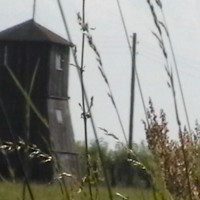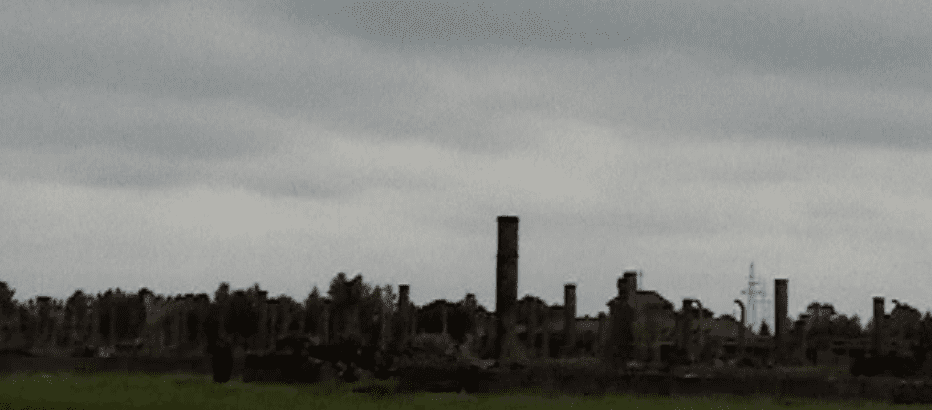Helen Levinson was fourteen years old in the 1940s when she left Lublin, Poland. I was fifteen years old in 2005 when I arrived. Helen left alone. I arrived with my sister. Helen left pretending that she was a Catholic. I arrived proclaiming myself a Jew.
Helen Levinson stood in front of me in a parking lot in Poland. A parking lot that was repaved and new. There was no marking upon the asphalt above the shallow grave of Helen’s father. Helen was the only one who knew to tell us he was there, she being the only survivor from her immediate family. Her father had been shot and killed trying to scale a fence out of his own brewery. The Nazis for whom he had been ordered to produce beer killed him. Helen was grateful to know where his body was—so few ever learned—though she lamented that the brewery had yet to place a plaque, as they had promised, acknowledging her father’s final resting place.
The brewery’s manager led Helen, four chaperones, and twenty-eight students—fourteen American and fourteen Israeli—inside and upstairs to an open hall. The room looked as if it had just been redone. The concrete floor was clean and even. The tables were shiny and new. The room was empty of clutter and shelving. Through great arched windows in the walls it was possible to see what remained of Majdanek concentration camp down the road. Unlike many other Nazi camps Majdanek is not far removed from heavily populated areas, but within Lublin city limits. Through the window was the first glimpse I had seen of the camp. Most striking was the great rounded mausoleum in the distance. A mausoleum that covered a giant pile of ash and bone fragments that had been collected from the Majdanek fields and surrounding area after World War II. Helen had not only survived the war and the Holocaust, she had survived Majdanek.
The mausoleum stood out over Helen’s shoulder as the twenty-eight of us sat down at long tables. In the traditional manner of covering one’s head before prayer, and lacking anything else, Helen pulled a napkin from her purse and placed it over her head. She and twenty-eight high school students said Kaddish for her father. She had never said the Jewish prayer of remembrance and mourning in that place before.
*
Majdanek is not like Treblinka or Auschwitz Birkenau, two of the better-known concentration camps of the Holocaust. Treblinka is gone, today merely a field and forest of memorials. There are huge stone rectangles representing oversized train tracks and a monument at camp’s center, some fifteen feet high. There are no buildings, only small rock markers, like headstones, bearing the names of lost towns and communities. All are polished, though their edges arc in natural curves or jagged spikes, as if they were pulled sharply from the ground rather than set gently down upon it. It takes balance to place a pebble atop a marker, to indicate my visit and my remembrance. Treblinka was not a labor camp, but an extermination camp, constructed for murder alone, rather than work. The camp was closed before it could be liberated. The Nazis hoped that by destroying it in its entirety, the evidence of their crimes would disappear with it.
Auschwitz Birkenau exists today in pieces. Chimneys from dismantled barracks dot the landscape almost as far as the eye can see. Explosives destroyed the gas chambers at Birkenau, so all that remains are heaps of rubble at the back of the camp. The rubble is surrounded by handfuls of wildflowers. Only the train tracks and great brick entrance, so recognizable from Schindler’s List, seem to remain undisturbed. The grass grows particularly thick across the site. We walked the train tracks into the camp. But we also got to walk them back out again, balanced on the rails or stepping from wooden tie to wooden tie. Some of the luckier ones imprisoned at Auschwitz Birkenau walked that path out as well.
At Majdanek, though, everything seems to be standing just as it was. It looks as if the whole place could resume its monstrous work again if someone were to merely flick an invisible switch. It is not a museum. It is not a memorial. It is evidence.
When we entered Majdanek through its fence and memorial I stood at the top of the stone steps and filmed the group’s descent into the camp proper. I could see the apartment buildings that rose just outside the camp’s perimeter. How do you sell an apartment like that? Advertising beautiful views of a historic concentration camp? But perhaps I was thinking too hard. Perhaps I was taking things too personally. I caught sight of a pair of picnickers settled on the grass beside the entry gate’s memorial. A blanket spread between them, the pair didn’t seem to consider the meaning of the structures that surrounded them. They did not turn to watch us as we marched past.
At Majdanek, there are barracks of wood, crammed with three tiered bunks. The barracks still smell as I walk past them. The smell is indefinable, neither smoke, nor rot, nor sweat, but everything and more. I know I do not want to walk inside. I am almost grateful for the metal gate that bars my way into the building. There is one barrack that has had all of its bunks removed. Instead, it is lined with chain link boxes full to bursting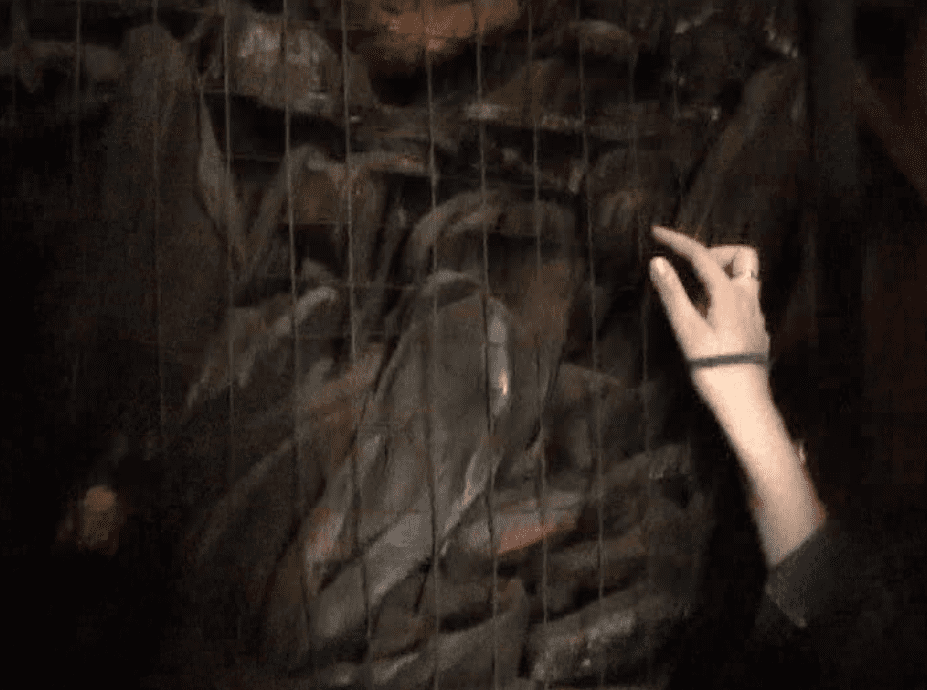 with shoes of every size. These are not the shoes people see behind glass at Auschwitz or in photographs in history books, these are shoes I can walk up to and touch. They are real. They are open to the world, to the air, to me. At Majdanek I can walk through the crematoria. Brick ovens still stand. I can see the silver table with its drain in the center, where they used to operate on bodies in the hopes of pulling riches from teeth or body cavities. A cast of this very table is on view at the United States Holocaust Memorial Museum.
with shoes of every size. These are not the shoes people see behind glass at Auschwitz or in photographs in history books, these are shoes I can walk up to and touch. They are real. They are open to the world, to the air, to me. At Majdanek I can walk through the crematoria. Brick ovens still stand. I can see the silver table with its drain in the center, where they used to operate on bodies in the hopes of pulling riches from teeth or body cavities. A cast of this very table is on view at the United States Holocaust Memorial Museum.
At Majdanek, they still have the showers and the gas chambers. It is possible to walk from one to the other. It is possible to stare up at the showerheads that hang in long rows from the ceiling. They are dull and gray and dusty. It is possible to see the green and blue stains on the cement walls left over from the Zyklon B gas that was used to murder many of Majdanek’s 80,000 victims. It is possible to touch these walls, though I did not. It is possible to see the chutes in the ceiling through which these gas pellets were released and the openings in the wall through which truck exhaust was sometimes funneled. It is possible to look through the small peepholes in the room doors. Those holes that guards would use to check to see if everyone inside was dead.
It was only possible for me to walk through these rooms, to follow my friends into the chambers, because I had brought my video camera with me. Upon my acceptance into the traveling summer program I had promised to document the trip in its entirety for the trip’s sponsor—the Jewish Community Federation of Rochester—and for myself. I had promised that this trip, the first of its kind between Rochester, New York and its sister city of Modi’in, Israel, of teens traveling with a Holocaust survivor to understand our shared history, would not only be available to those of us lucky enough to participate. This promise forced me to scale the emotional wall I found between the showers and myself. I told myself I had to walk through and I did, my camera held firmly in front of my eyes.
Helen walked through those rooms with us. Helen, who had also walked with us, we twenty-eight teenagers, through Washington, DC and the National Holocaust Museum, and Oswego, New York and Fort Ontario, which sheltered over a thousand war refugees, the majority of whom were Jewish. In Majdanek we walked with Helen, who had avoided those very rooms, rooms that had stolen her community and her childhood, some sixty years before. Helen, who had returned to the very country my own mother said she was not yet ready to see.
Helen had come on a trip that had brought the question of “why?” to my own grandmother’s lips when she had heard I was going. Why revisit horrors when my family had worked so hard to build my happiness? Helen had come on a trip that had set my great-grandparents to “rolling in their graves” according to my mother, and visiting her in accusatory nightmares. How could my mother let me return, they wanted to know, to a place that had left them cowering in fear as pogroms passed through their villages?
Perhaps I was able to go because I was young. Perhaps it was because I had never been presented with the opportunity to examine the Holocaust in great detail. Perhaps I didn’t know enough to be afraid. Most of what I knew about the Holocaust I’d learned from a picture book in Hebrew school and through a smattering of Hollywood films—Schindler’s List, The Pianist, The Diary of Anne Frank. My parents had taken me to the Yom Hashoah, Holocaust Remembrance Day, commemorations at the local JCC. They talked to me about the Holocaust. But I had not been asked to, or taken the initiative, to explore the story of the Holocaust myself.
In the Holocaust I had lost no close relations. I did not have the personal recall of history, like my grandparents. I had not heard firsthand the stories from now-deceased relatives about fleeing the old country. I had not been told the tales of Russian pogroms, or about the wait for visas. I knew my family had come from Lithuania, Minsk, and Poland, but I didn’t understand how hard-fought that trip toward a new home had been.
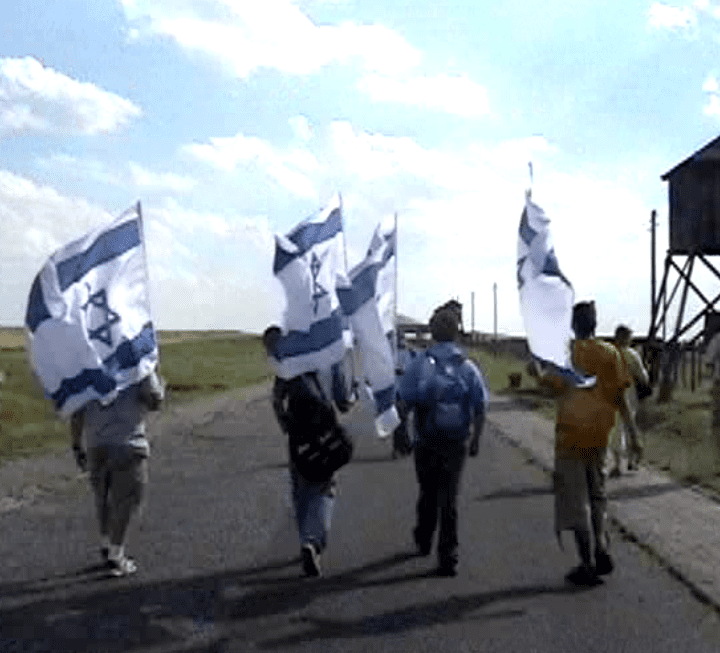 But I understood something important had been lost in Europe and I made the choice to go to Poland myself. No Jews were spared in the Holocaust simply because of particular family ties, including non-Jewish relatives. No Jews were spared because they’d been spared before. I certainly lost something, whether it is connected to my immediate family or not. There was a part of my history no one would ever be able to relate to me. There was a comfort that would never be regained. My grandmothers worried over this trip, not merely because I was traveling without my parents, but because of the particular destination. My return to Poland, a country where members of my family had fled decades before I was born, upset my grandmothers because they had heard the stories that I had not. They had grown up under the shadow of the past, and the tales of forces, both large and small, that had driven my family across the Atlantic. They did not trust me to travel with a chamsah, a hand of God emblazoned with a Star of David, around my neck. The pictures of my friends and I walking through concentration camps with Israeli flags held aloft or draped across our shoulders that they received over email scared them. They worried that I would be too much of who I was in a land that had already proved even the smallest display of my religion was grounds for persecution.
But I understood something important had been lost in Europe and I made the choice to go to Poland myself. No Jews were spared in the Holocaust simply because of particular family ties, including non-Jewish relatives. No Jews were spared because they’d been spared before. I certainly lost something, whether it is connected to my immediate family or not. There was a part of my history no one would ever be able to relate to me. There was a comfort that would never be regained. My grandmothers worried over this trip, not merely because I was traveling without my parents, but because of the particular destination. My return to Poland, a country where members of my family had fled decades before I was born, upset my grandmothers because they had heard the stories that I had not. They had grown up under the shadow of the past, and the tales of forces, both large and small, that had driven my family across the Atlantic. They did not trust me to travel with a chamsah, a hand of God emblazoned with a Star of David, around my neck. The pictures of my friends and I walking through concentration camps with Israeli flags held aloft or draped across our shoulders that they received over email scared them. They worried that I would be too much of who I was in a land that had already proved even the smallest display of my religion was grounds for persecution.
But when vandals drew a swastika on my younger sister’s car in her high school parking lot they did not care that her family had left Europe before World War II broke out. As boys pitched pennies at the back of my brother’s head as he stood at his locker, it didn’t matter to them that my brother considered himself more of an agnostic then. When Poles throw eggs or water at visitors to the Warsaw Ghetto wall, as our tour guide recounted, they do not aim for visitors who have lost family or friends, they do not care if they call Poland, or Israel, or America their home, they take the whole group as one.
The one time I cried while traveling through Poland was in the middle of a densely packed forest. I sat on a small incline, beside my sister and my friend Eric, staring down at a small patch of earth between the trees that had been gated off by a rectangular fence. A poster board, written in Hebrew, leaned against the enclosure, a picture of a small boy pasted to its center. It was a mass grave. It was the second such forest site we had been introduced to over so many days. But as our guide explained about the forced march of Jews to their death beneath these particular pines, she informed us the grave we sat before was of special significance. It was the final resting place solely of the Jewish community’s children. As she described for us a scene of children being ripped from their parents’ arms each of us was handed a letter.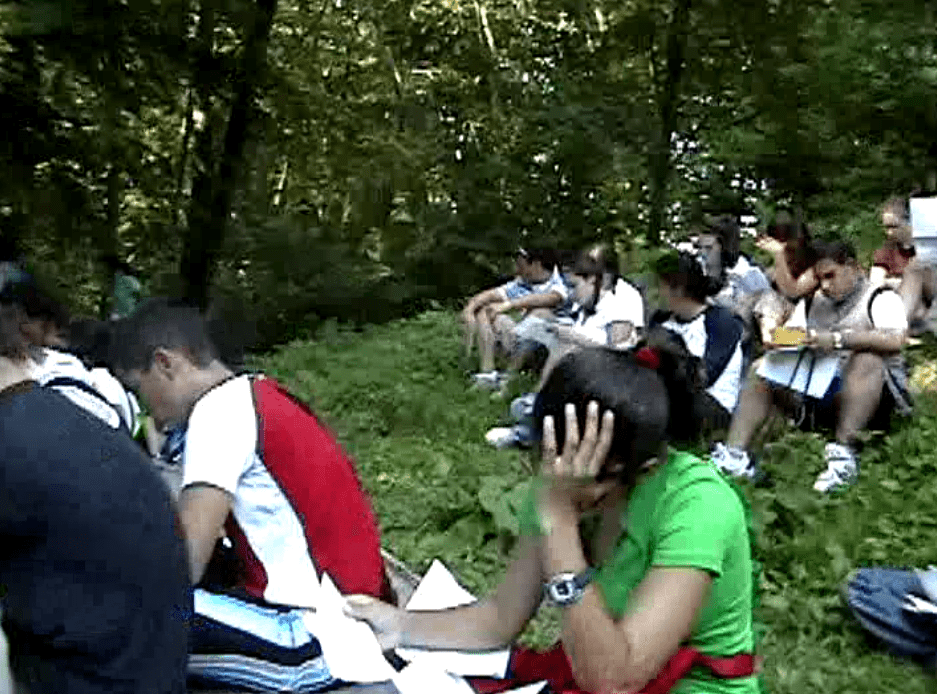 A letter written to us by our own parents, without our knowledge, and secreted away with our chaperones until we found ourselves sitting, without our families, in the middle of a Polish wood.
A letter written to us by our own parents, without our knowledge, and secreted away with our chaperones until we found ourselves sitting, without our families, in the middle of a Polish wood.
The thought of home made sense to me. The idea that, even beside a grave of lost children, my parents could reach me and tell me the things I needed to hear, the fact that my home, so very far away, was still a place where I was known, a place that made me feel safe enough to venture out into the much larger world, was something I could understand. And it was in understanding that I broke down.
*
Helen was the only one of us, aside from our tour guide, who spoke Polish. She acted as interpreter on the streets of Lublin, and Warsaw, and Krakow to those of us in the back of the group, far from our guide’s ear. She spoke to children who approached us as we sat outside the remains of a Jewish orphanage. She spoke to museum curators who asked where it was we were from. She talked over the phone to Polish Pizza Hut when we found the kosher fare we’d been served too terrible to eat. We students took turns carrying her purse and holding her hand. Sometimes she would just talk to us. She told us stories about her life in Poland, not just the story of her leaving. She talked about her siblings and her father. She told us about the many grandchildren she now had living in Israel, the family she was going to visit when we all boarded a plane for the last leg of our journey and headed to the “Holy Land” together. She told us how glad she was that we had come with her. I don’t know that we ever said it enough, but we were glad she had come with us too.
But one time Helen didn’t speak, she sang. I walked at her shoulder. I wore a t-shirt and shorts, gray Puma sneakers, and my video camera slung over my shoulder. The camera slapped at my hip, silent and dark. On the streets of Poland, the country from which she had fled, amongst the normal bustle of a modern city street, Helen sang in her childhood tongue a lullaby she remembered hearing from her mother. She sang in Polish to a group of English and Hebrew speaking teenagers. We did not need her to translate its meaning.
***
All photographs provided by author.
